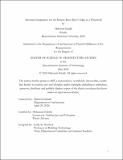Alternate Imaginaries for the Kinara: River Ravi’s Edge as a Threshold
Author(s)
Khalil, Mahwish
DownloadThesis PDF (11.13Mb)
Advisor
Nahleh, Mohamad
Terms of use
Metadata
Show full item recordAbstract
In the lower riparian landscape of Punjab, Pakistan, various communities confront the challenges of living within the active floodplain of river Ravi as it flows alongside the city of Lahore. These communities navigate the dissonances of the river’s edge—its Kinara, marked and molded by persistent colonial (mis)representations rooted in practices of erasure and division. Stepping away from historical depictions that have reduced the river to a mere resource for acquisition, this thesis engages with design and the oral tradition of storytelling, known as Qissa Khwani, to propose new modes of knowing, witnessing, and ultimately, cultivating alternative imaginaries for Ravi. This thesis seeks to illuminate the overlooked narratives of a river and its communities by drawing inspiration from, and centering the voices and legacies of, those most impacted by regressive depictions of a linear floodplain. It stages newer encounters and engagements with Ravi and its communities by stitching together stories of numerous community members, the dwellers, the boatmen, and the civil defense divers, actively defying and transforming the seemingly static Kinara—their home—through cultural and economic production. These pluralistic alternatives serve as a deliberate departure from the current large-scale, mega-urban development projects planned for the riverfront, which not only overlook the communities living along its banks but also employ idealized depictions of Ravi to attract capital. Finally, this thesis questions how the river's edge can be remapped to allow for the dismantling of top-down visions while addressing an urgency embodied within the shallow, receding flows of a polluted river, whose uncertain future remains contingent on distinct lines.
Date issued
2024-05Department
Massachusetts Institute of Technology. Department of ArchitecturePublisher
Massachusetts Institute of Technology